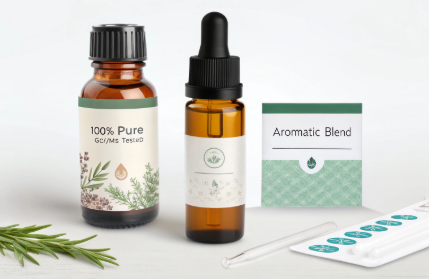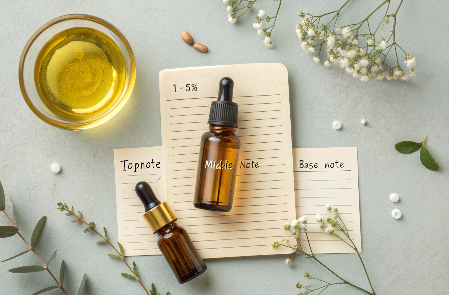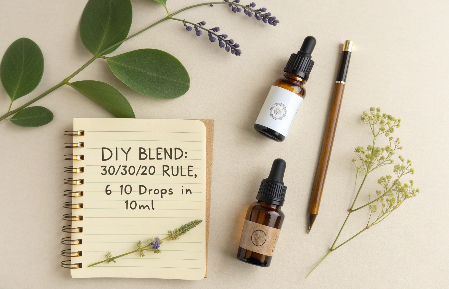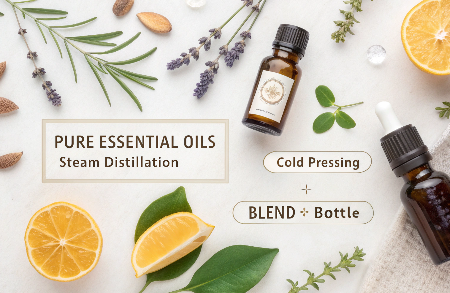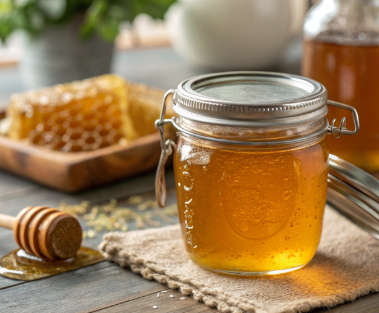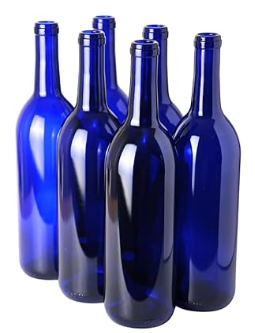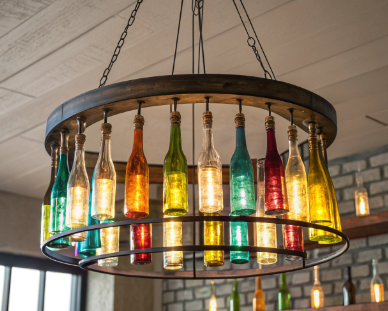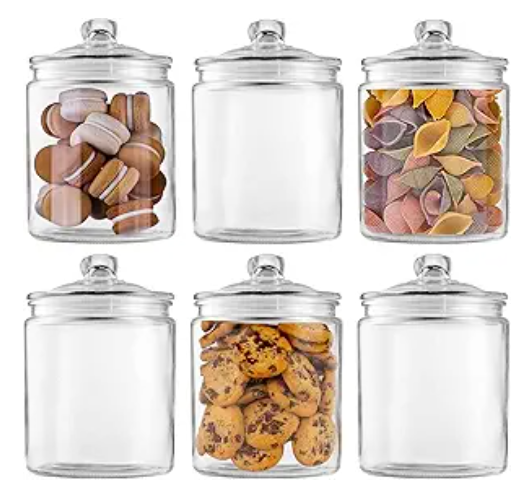Creating aromatherapy oils is a blend of art and science—selecting the right essential oils, balancing their notes, and pairing them with a suitable carrier. Whether for stress relief, better sleep, or an energy boost, the right blend can transform both mood and skin.
To make aromatherapy oils, mix essential oils with a carrier oil following a dilution ratio (typically 1–5%). Use the 30/50/20 rule to balance scent: 30% top notes, 50% middle notes, 20% base notes.
Let’s explore how to build blends that smell amazing, feel luxurious, and deliver real therapeutic value.
How to make your own aromatherapy oil?
It’s easier than you think—with the right ingredients and measurements.
To make your own aromatherapy oil, choose 2–3 essential oils, dilute them into a carrier oil like jojoba or almond, and store the blend in a dark glass bottle. Shake gently before use.
Dive Deeper: DIY Aromatherapy Blend Recipe
You’ll need:
-
10ml carrier oil (jojoba, fractionated coconut, sweet almond)
-
6–10 drops of essential oil blend (1–5% dilution)
-
Amber or cobalt dropper bottle
Step-by-step:
- Choose oils by therapeutic goal (e.g., lavender + bergamot for calm).
- Use the 30/50/20 rule for balance (see next section).
- Blend oils first, then add to carrier.
- Shake gently and label (name, ingredients, date).
Dive Deeper: How Are Aromatherapy Oils Made?
If you want to craft your own essential oils from scratch, here’s a peek behind the curtain at how it’s done:
1. Harvest Your Plant Material
Start with fresh, high-quality plant material. The timing of harvest matters—many plants, like lavender, yield the most oil just as blossoms begin to wilt. Most plants should be distilled immediately, but if you need to wait, dry them in a cool, airy place away from sunlight.
Pro tip: For lavender, hang small bundles upside down to dry for 2–4 weeks before storing in airtight containers.
2. Prepare and Clean Your Distillation Equipment
Always start with a clean still or distillation setup. Food-grade cleansers likeProfessional Brewers Wash (PBW)work well for both stainless steel and copper.
3. Add Plant Material and Water
Place whole plant parts (don’t chop too fine or you’ll lose oils) in the still. Add distilled water—enough to cover the plant material, but not so much that it risks boiling over.
4. Heat and Distill
Heat the still until the water boils. Once boiling, turn on the condenser (if your setup has one) and watch as steam carries the essential oils out through the drip-arm. Keep an eye on water levels so the still never runs dry.
5. Collect and Separate
Direct the distillate into a separatory funnel. Allow the mixture to settle—oil will float above the hydrosol (floral water). After 12 hours or so, drain each into separate containers.
6. Store Properly
Pour your essential oil into airtight, tinted glass bottles, leaving minimal air space. Store hydrosol in clear glass. Both should be kept cool and dry for maximum shelf life.
7. Clean Up
Rinse the still thoroughly and use a food-safe cleanser to remove any trace oils. For copper, dilute your cleanser to half-strength.
Whether you’re blending ready-made essential oils or venturing into home distillation, taking care with each step ensures your final blend is as potent and pure as possible.
AtPauPack, we supplyready-to-fill oil bottleswith pre-calibrated dropper caps, perfect for beginner aromatherapists and boutique brands.
What is the 30 50 20 rule for essential oils?
Fragrance harmony starts with structure.
The 30/50/20 rule helps balance an essential oil blend: 30% top notes, 50% middle notes, and 20% base notes. This creates a scent that opens well, lingers, and grounds.
Dive Deeper: Understanding Each Note
| Note Type | Characteristics | Common Oils |
|---|---|---|
| Top (30%) | Light, sharp, evaporate fast | Lemon, peppermint, eucalyptus |
| Middle (50%) | Heart of the blend | Lavender, geranium, rosemary |
| Base (20%) | Heavy, grounding, long-lasting | Patchouli, cedarwood, sandalwood |
Example (10-drop blend):
-
3 drops orange (top)
-
5 drops lavender (middle)
-
2 drops vetiver (base)
Add this blend to 10ml of carrier oil for a 5% dilution—ideal for pulse-point rollers or massage oils.
At PauPack, we help clientsdesign blend templatesand createpre-filled 10ml roll-onswith balanced fragrance profiles.
How are aromatherapy oils made?
Some are blended, some are extracted—it depends on the type.
Aromatherapy oils are made by either extracting essential oils from plants or blending those oils with carriers to create ready-to-use products.
Dive Deeper: Two Categories
-
1.Essential Oils (Pure)
- Extracted from plants (flowers, leaves, peels)
- Methods: steam distillation, cold pressing
Some botanicals store their essential oil within their leaves or flowers, while others keep the oil tucked away in their rinds, seeds, or even roots. For example, citrus oils likeorangeandlemonare pressed from the fruit’s peels, whereas floral oils such aslavenderare distilled from the blossoms. The part of the plant used determines both the extraction method and the oil’s unique properties, making each essential oil distinct in aroma and benefit.
Why harvest timing and technique matters
It’s not just what you distill—it’s when and how you pick it.
The timing and care taken during plant harvest have a huge impact on both the yield and quality of the essential oils you’ll get.Each plant species produces its highest essential oil content at specific points in its growth, so harvesting too early or too late can mean less fragrance and fewer active compounds.
Handle with a light touch:
- Pick the correct plant part (petals, leaves, peels, etc.)
- Harvest at the optimal stage—often early morning, when compounds are most concentrated
- Avoid bruising or crushing, which can cause valuable oils to evaporate or degrade
A little research goes a long way. Check reputable sources (like theInternational Federation of Essential Oils and Aroma Tradesor publications from distillers such asMountain Rose Herbs) to pinpoint the ideal harvest window for your botanicals. Good technique preserves both potency and aroma, ensuring your final blend is as vibrant and therapeutic as possible.
2.Aromatherapy Blends
-
Mixed with a carrier (e.g., jojoba)
-
Used directly on skin, in roll-ons, or massage oil
AtPauPack, we manufacture and packagecustom aromatherapy blendsfor beauty, spa, and wellness clients—offering bothbulk oil solutionsandretail-ready formats.
How do I extract essential oils?
It’s complex—but possible at a small scale.
Essential oils are extracted from plants using steam distillation, cold pressing, or solvent extraction, depending on the botanical.
Should You Cut or Chop Plant Material Before Distillation?
Keep plant material whole for best results. While it might be tempting to chop or shred botanicals before distilling, this can actually cause you to lose valuable oils before extraction even begins. Cutting exposes more surface area, allowing delicate aromatic compounds to evaporate or stick to your tools.
Instead, load the whole leaves, petals, or peels directly into your still. This helps preserve the maximum amount of essential oil, ensuring a richer, more aromatic final product. For roots or very dense materials, a gentle break (not a fine chop) may be needed, but always err on the side of keeping pieces as intact as possible.
Dive Deeper: Common Extraction Methods
| Method | Ideal For | How It Works |
|---|---|---|
| Steam Distillation | Herbs, flowers | Steam pulls volatile oils from plant matter |
| Cold Pressing | Citrus peels | Pressing releases oil without heat |
| Solvent Extraction | Delicate florals | Uses alcohols or hexane (not DIY-safe) |
Exploring Home Essential Oil Distiller Systems
If you're intrigued by the idea of making your own essential oils at home, a distiller can help you extract plant essences safely and efficiently. There are two main types of electrical distillers designed for home use—both offering different advantages depending on your goals and setup.
1. 120-Volt Essential Oil Distillers
Best for beginners and smaller batches, 120v distillers are plug-and-play systems that work with standard household outlets. Here’s why people like them:
- Simple Setup: Just plug into your kitchen outlet and you’re ready to start.
- Perfect for Hobbyists: Ideal if you’re experimenting with small harvests or want to try making lavender or peppermint oil in limited quantities.
- Affordable & Accessible: Lower upfront cost and easy to find.
Considerations:
These systems heat up and extract more slowly, so patience is required. They’re not designed for producing big batches—and won’t keep up if you plan to distill gallons at a time.
2. 240-Volt Essential Oil Distillers
If you're looking for faster results or need to process larger amounts (hello, ambitious gardeners), a 240v system is worth considering. Here’s what sets them apart:
- More Power, Faster Extraction: Reach distillation temperatures quickly and extract oils efficiently, especially during big harvests.
- Larger Volume: Great if you’re making essential oils for friends and family, or growing your own botanicals at scale.
- Commercial-Grade Results: Higher yields in less time—meaning you can run multiple cycles in a single day.
Considerations:
You’ll need access to a 240v outlet (such as a dryer outlet) and possibly help from an electrician for setup. These systems are more of an investment, both in terms of price and electricity.
Distillation Tips for Success
- Regularly inspect your distiller for safe operation and optimal performance.
- Always ensure your system has adequate water to protect the heating element.
- Adjust temperature and power settings as needed to avoid losing precious steam from the condenser.
Whether you're starting small with a 120v plug-in model or scaling up to a 240v setup for garden-sized projects, modern distillers from reputable brands likeStill Spirits,Vevor, andAlambicmake home extraction accessible.
DIY extraction is possible using ahomemade still, but commercial-grade oils are more consistent, safer, and cost-effective for most users.
AtPauPack, we sourceISO-certified essential oilsfrom trusted global suppliers and offer private-label services for custom aromatherapy lines.
Key Factors for Successful Essential Oil Distillation at Home
Good distillation starts long before you flip the switch on your still. Here’s how to set yourself up for quality results—whether you’re a hobbyist or considering small-batch production.
1. Harvesting at the Right Time
- The timing of your harvest is crucial; essential oil yield and quality peak at particular stages of a plant’s life.
- Research each plant’s best harvest window. For example, cut lavender just as its blooms begin to fade for optimal aroma.
2. Careful Handling and Preparation
- Handle your botanicals gently. Rough handling or harvesting the wrong parts can reduce potency—think of it as preserving the plant’s “character” before its star moment on stage.
- Most fresh plant material should be distilled promptly. If delays are unavoidable, dry your botanicals in small bundles in a cool, well-ventilated place out of direct sunlight. This helps prevent spoilage.
3. Smart Sizing and Storage
- Keep plant pieces as whole as possible. Chopping can release volatile oils prematurely.
- Once dry, store in airtight containers until you’re ready for extraction—just like you’d keep your favorite coffee beans protected from the air.
4. Clean Equipment, Every Time
- Residue from past batches can muddy new oils. Clean your still thoroughly—PBW (Professional Brewers Wash)is a food-grade choice approved for both stainless steel and copper. For copper, dilute it to half strength.
5. Precision With Water and Heat
- Use distilled water for the purest results. Fill your still enough to cover the heating element without risking overflow.
- Monitor heat and maintain steady boiling. Steam distillation is mostly hands-off, but never allow the still to run dry—it’s tough on your equipment and your nerves.
6. Efficient Separation and Storage
- Collect the distillate in a separatory funnel, then let it sit to allow the oil and hydrosol to naturally separate.
- Store essential oils in tinted, airtight glass bottles (think amber or cobalt) and hydrosols in clear glass—both in a cool, dry spot to maximize shelf life.
7. Practice and Patience
- Distillation is as much art as science. Experiment, take notes, adjust—and don’t be discouraged if your first batch isn’t perfect. Each plant, season, and session will teach you more.
With these essentials in mind, you can extract pure, aromatic oils that rival many commercial offerings—whether for your own blends or boutique products.
Conclusion
Making aromatherapy oils is simple with the right essential oils, carrier, and balance. Use the 30/50/20 rule, stick to safe dilutions, and store in dark glass. AtPauPack, we help you craft and scale your blends—from custom packaging to full white-label production.
For best results, always store your finished oils in airtight, tinted glass containers, leaving as little headroom as possible to reduce oxidation. If you’re working with hydrosols, clear glass is fine, but both should be kept in a cool, dry place to maximize shelf life and preserve aromatic potency.




